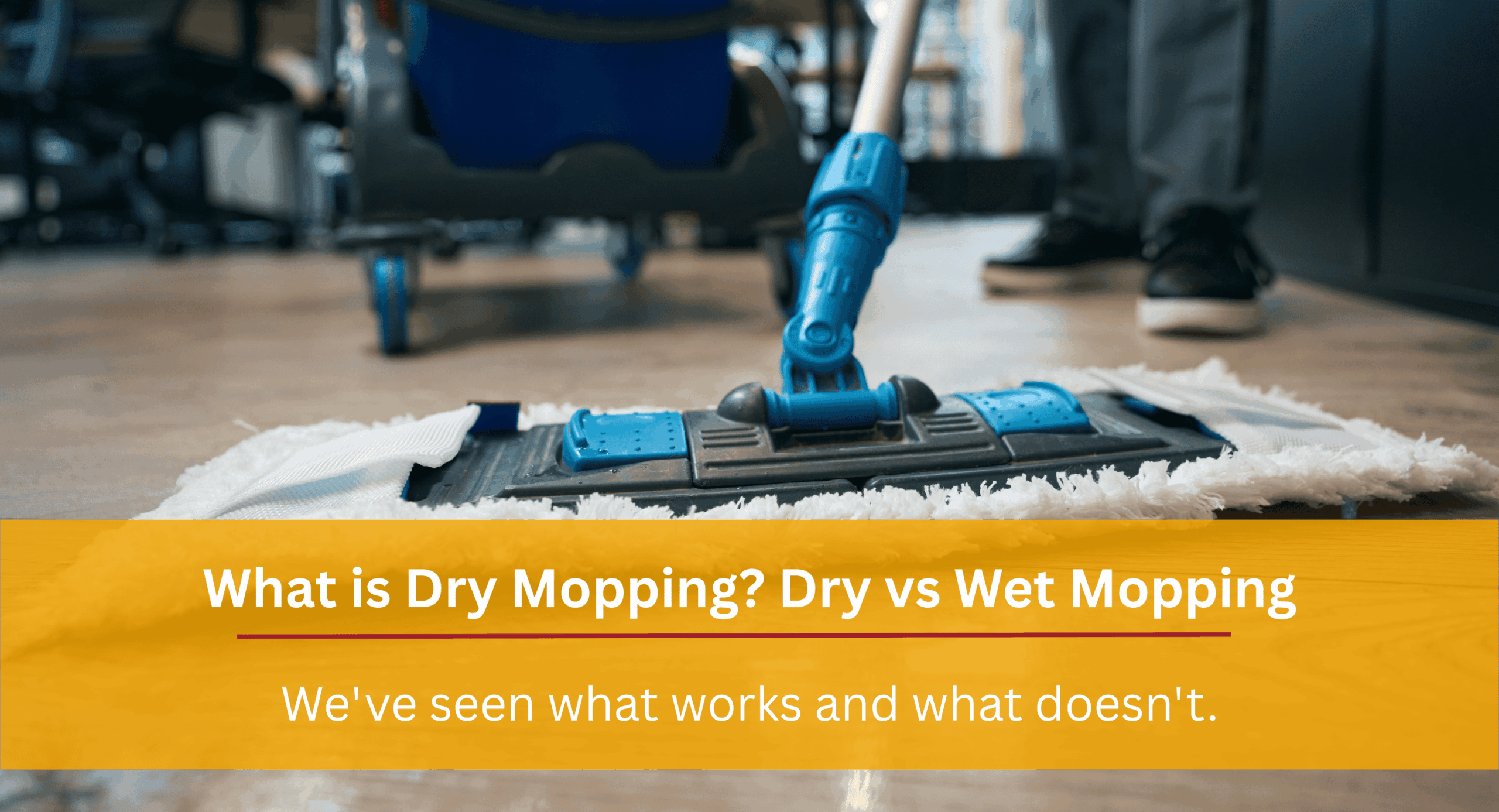Most people think mopping means water and soap. Get a bucket, grab a mop, and scrub away. But that's only part of keeping floors clean.
Dry mopping might sound odd, but it's one of the best ways to maintain floors between deep cleanings. Most businesses skip this step and then wonder why their floors always look dusty or why regular mopping doesn't work well.
Knowing when to dry mop versus when to use water can save you time and keep your facility looking good. At Ace ImageWear, we've helped businesses manage floor care for decades through our mop rental services. We've seen what works and what doesn't.
Here's the real difference between dry and wet mopping, and why you need both.
Dry Mopping: The First Line of Defense
Dry mopping catches all the stuff that accumulates on your floors throughout the day - dust, dirt, crumbs, and debris that walking around kicks up. It's like sweeping, but more thorough and less likely to just push dirt around.
Purpose of Dry Mopping
The main goal of dry mopping is to remove dry particles like dirt, dust, and sand. These particles can scratch floors, create slip hazards, and make your space look unkempt. In environments like warehouses, production floors, or even high-traffic office areas, dry mopping helps maintain a tidy and professional appearance.
The Best Method for Dry Mopping
Dry mopping uses a flat or treated dust mop that you push across the floor to collect debris. Work in overlapping passes, starting from one side of the room and moving across steadily. Change mop heads as they get saturated with dirt to avoid dragging particles around.
Benefits of Dry Mopping
- Captures loose dirt and debris before it spreads
- Extends the lifespan of wet mops by removing surface particles
- Reduces dust buildup and improves air quality
- Keeps floors cleaner between deep cleanings
- Minimizes safety hazards caused by loose grit
Ace ImageWear supports this process with a mop rental service that provides clean, laundered dry mops on a regular schedule. You don’t need to worry about storing or washing used mop heads, Ace handles that for you.
The Limitations of Dry Mopping
Dry mopping cannot clean up spills, grease, or any sticky residue. It removes visible dirt but does not sanitize or disinfect. In workspaces where hygiene is necessary, like food processing or bioscience labs, you must follow dry mopping with wet mopping to meet standards.
When to Use Dry Mopping
Use dry mopping daily or multiple times per day in busy areas. It works best before wet mopping or as a quick cleanup method between shift changes or before inspections.
Wet Mopping: For Deep Cleaning and Sanitizing
After removing dry debris, wet mopping steps in to clean and sanitize the floors. This two-step process ensures you are not just moving dirt around but actually removing it.
Purpose of Wet Mopping
Wet mopping tackles the grime that dry mopping leaves behind. Spills, muddy footprints, grease, and other stubborn residues require more than a quick sweep. To remove these, you need water, cleaning solution, and a thorough mopping process.
Commercial kitchens and manufacturing plants can't just worry about how floors look. Wet mopping removes bacteria, chemical spills, and other nasty stuff that could make people sick or get you written up by health inspectors. Some contamination won't come off any other way - you need soap, water, and scrubbing to actually get floors clean enough to be safe.
Some messes simply cannot be addressed without proper wet cleaning, regardless of how often you dry mop.
Your Go-To Method for Wet Mopping
Start with a clean mop and a bucket filled with water or an approved cleaning solution. Wring out excess liquid to avoid oversaturating the floor. Mop in sections, rinsing the mop frequently and replacing dirty water as needed. Always allow floors to dry before allowing foot traffic.
Benefits of Wet Mopping
- Removes grease, sticky messes, and stains
- Provides a deeper clean for high-use areas
- Helps meet sanitation requirements
- Keeps floors looking polished and professional
- Supports safety in food, chemical, and healthcare environments
Ace ImageWear provides both wet and dry mop options through our facility services. These freshly laundered mops arrive regularly, so your staff always has clean tools for the job.
Limitations of Wet Mopping
Wet mopping takes more time and can leave floors slippery while drying. It also cannot pick up large debris, so skipping the dry mop step often leads to streaks and leftover residue. Wet mopping also requires consistent access to clean mops, which is where a dependable rental program becomes essential.
When to Use Wet Mopping
Use wet mopping daily in break rooms, food prep areas, restrooms, and any space where spills happen. It removes grease, stuck-on dirt, and anything dry mopping cannot reach. In industries like food processing or manufacturing, follow dry mopping with wet mopping to ensure floors meet sanitation standards and pass inspections.
Wet mopping also helps keep high-traffic areas like shared entryways, loading docks, or production zones looking professional and safe for workers and visitors alike.
Let Ace ImageWear Keep Your Floors Covered!
Manufacturing, bioscience, food processing, and other hands-on environments demand spotless floors. Ace ImageWear supports your cleaning efforts with dependable mop rental services as part of our facility management offerings.
Pair your mop rental with our uniform programs to give your team everything they need to stay clean, safe, and professional. With nearly 90 years of experience, Ace ImageWear brings local service, personal attention, and smart solutions to businesses in Kansas City, Houston, and surrounding areas.
Want to streamline your cleaning routine? Contact Ace ImageWear today to get started with facility services you can count on.

